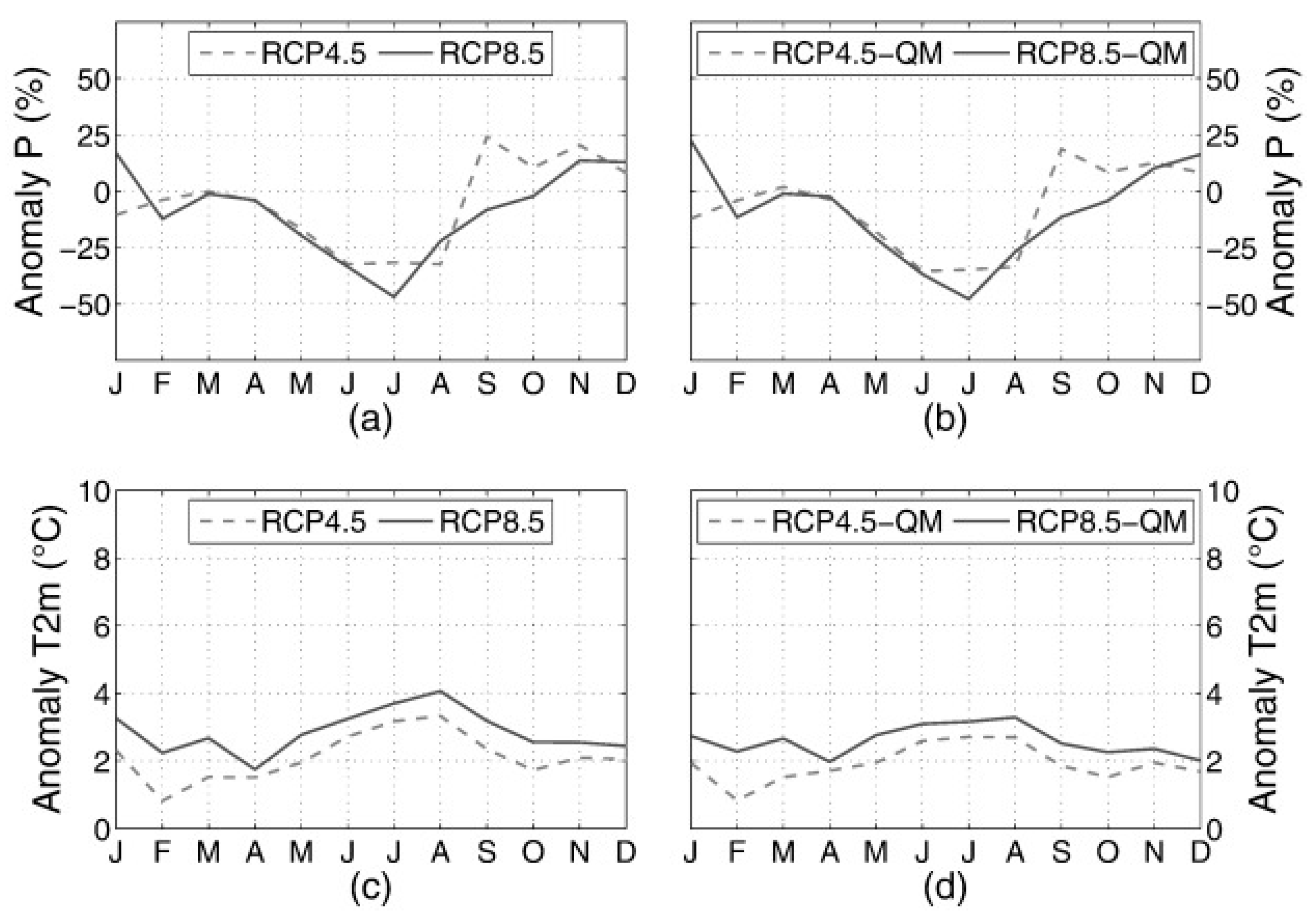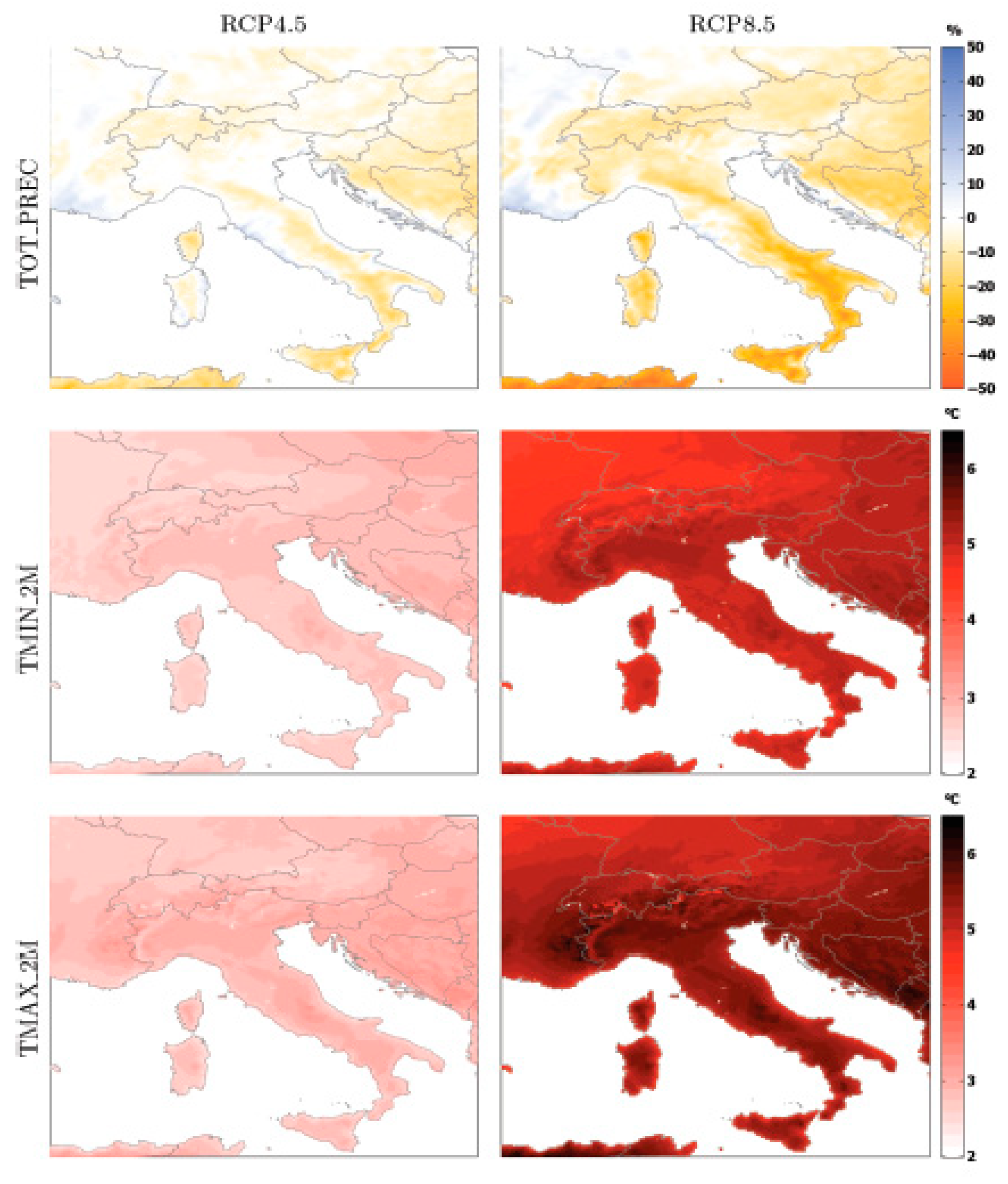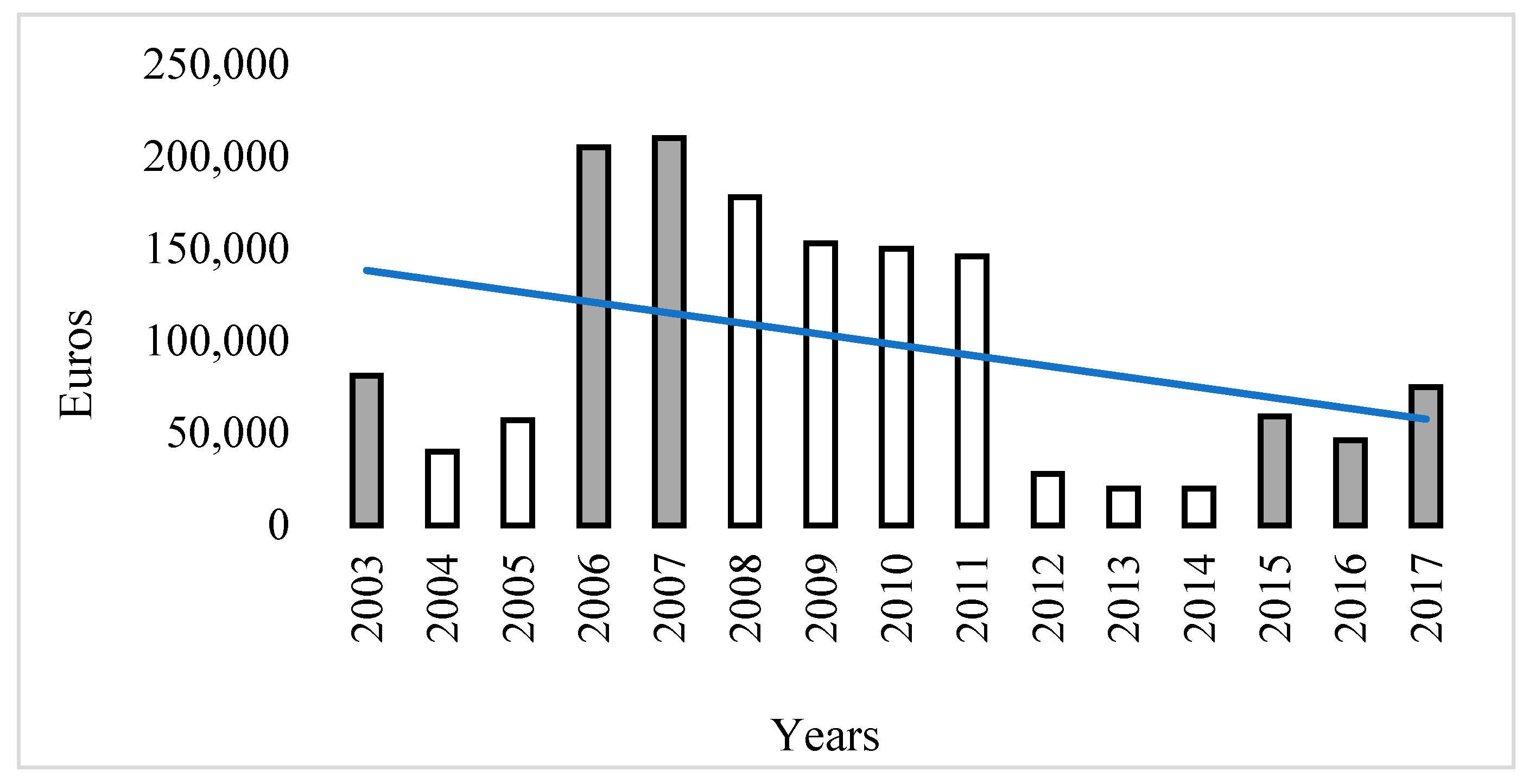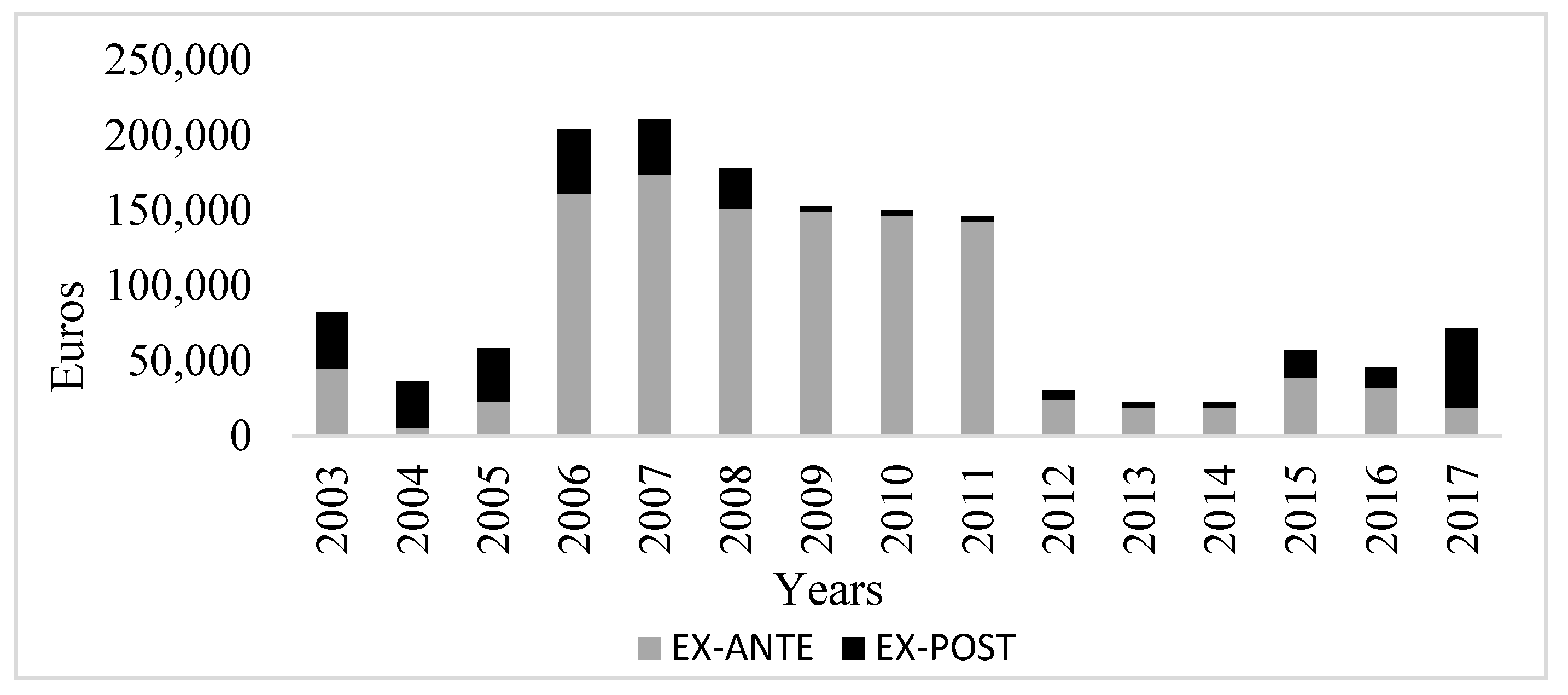Measuring the Transaction Costs of Historical Shifts to Informal Drought Management Institutions in Italy
Abstract
1. Introduction
1.1. The study of Transaction Costs
1.2. The Contribution of this Study
2. Historical Institutional Analysis
2.1. Water Abstraction Licenses Regime in Italy: An Obstacle to Climate Change Adaptation
2.2. Formal Drought Management Institutions
2.3. Informal Arrangements for Drought Management—The Case Study
3. Materials and Methods
3.1. Stakeholders, Interviews, Document Analyses, and Assessment of Governance Arrangements
3.2. Transaction Costs Data Collection, Categorisation and Analysis
4. Results
4.1. Stakeholder Map and Assessment of Drought Governance Arrangements
4.2. Transaction Costs Measurement and Analysis
5. Discussion
5.1. Drought Management Arrangements
5.2. Transaction Costs and Policy Performance Analysis
5.3. Transaction Costs and Uncertainty Analysis
6. Conclusions
Author Contributions
Funding
Acknowledgments
Conflicts of Interest
Appendix A

References
- Pachauri, R.K.; Allen, M.R.; Barros, V.R.; Broome, J.; Cramer, W.; Christ, R.; Church, J.A.; Clarke, L.; Dahe, Q.; Dasgupta, P.; et al. Climate Change 2014: Synthesis Report. Contribution of Working Groups I, II and III to the Fifth Assessment Report of the Intergovernmental Panel on Climate Change; IPPC: Geneva, Switzerland, 2014. [Google Scholar]
- OECD. Water Resources Allocation: Sharing Risks and Opportunities; OECD Publishing: Paris, France, 2015. [Google Scholar]
- World Bank. High and Dry: Climate Change, Water, and the Economy; Water Global Practice; World Bank: Washington, WA, USA, 2016. [Google Scholar]
- North, D.C. Institutions, Institutional Change, and Economic Performance; Cambridge University Press: Cambridge, UK, 1990. [Google Scholar]
- Williamson, C.R.; Kerekes, C.B. Securing Private Property: Formal versus Informal Institutions. J. Law Econ. 2011, 54, 537–572. [Google Scholar] [CrossRef]
- World Bank. The Social Dimensions of Climate Change; World Bank: Washington, WA, USA, 2009. [Google Scholar] [CrossRef]
- Coase, R. The Firm, the Market, and the Law; University of Chicago Press: Chicago, IL, USA, 1990. [Google Scholar]
- Catlin, G.E.G.; Robbins, L. An Essay on the Nature and Significance of Economic Science. Polit. Sci. Q. 1933, 48, 463. [Google Scholar] [CrossRef]
- Pagano, U.; Vatiero, M. Costly institutions as substitutes: Novelty and limits of the Coasian approach. J. Inst. Econ. 2014, 11, 265–281. [Google Scholar] [CrossRef]
- Ostrom, E. A General Framework for Analyzing Sustainability of Social-Ecological Systems. Science 2009, 325, 419–423. [Google Scholar] [CrossRef]
- Coase, R.H. The Problem of Social Cost. J. Law Econ. 1960, 3, 1–44. [Google Scholar] [CrossRef]
- Coase, R.H. The Nature of the Firm. Economica 1937, 4, 386–405. [Google Scholar] [CrossRef]
- Williamson, O.E. The New Institutional Economics: Taking Stock, Looking Ahead. J. Econ. Lit. 2000, 38, 595–613. [Google Scholar] [CrossRef]
- Marshall, G.R. Transaction costs, collective action and adaptation in managing complex social–ecological systems. Ecol. Econ. 2013, 88, 185–194. [Google Scholar] [CrossRef]
- Krutilla, K. Transaction Costs and Environmental Policy: An Assessment Framework and Literature Review. Int. Rev. Environ. Resour. Econ. 2011, 4, 261–354. [Google Scholar] [CrossRef]
- McCann, L. Transaction costs and environmental policy design. Ecol. Econ. 2013, 88, 253–262. [Google Scholar] [CrossRef]
- Garrick, D.E.; Aylward, B. Transaction Costs and Institutional Performance in Market-Based Environmental Water Allocation. Land Econ. 2012, 88, 536–560. [Google Scholar] [CrossRef]
- McCann, L.; Easter, K.W. A framework for estimating the transaction costs of alternative mechanisms for water exchange and allocation. Water Resour. Res. 2004, 40, 1–6. [Google Scholar] [CrossRef]
- Landry, R.; Amara, N. The impact of transaction costs on the institutional structuration of collaborative academic research. Res. Policy 1998, 27, 901–913. [Google Scholar] [CrossRef]
- Hernández-Mora, N.; De Stefano, L. Los Mercados informales de Aguas en España: Una Primera Aproximación. In Usos Del Agua: Concesiones, Autorizaciones y Mercados Del Agua; Thomson Reuters Aranzadi: Cizur Menor, Spain, 2013. [Google Scholar]
- Santato, S.; Mysiak, J.; Pérez-Blanco, C. The Water Abstraction License Regime in Italy: A Case for Reform? Water 2016, 8, 103. [Google Scholar] [CrossRef]
- Mobarak, A.; Mushfiq, A.; Rosenzweig, M.R. Informal Risk Sharing, Index Insurance, and Risk Taking in Developing Countries. Am. Econ. Rev. 2013, 103, 375–380. [Google Scholar] [CrossRef]
- Sobels, J.; Curtis, A.; Lockie, S. The role of Landcare group networks in rural Australia: Exploring the contribution of social capital. J. Rural Stud. 2001, 17, 265–276. [Google Scholar] [CrossRef]
- Quiggin, J. Economics in Two Lessons; Princeton University Press: Princeton, NJ, USA, 2019. [Google Scholar]
- Werner, R. Measuring Transaction Costs. AIMR Conf. Proc. 2001, 2001, 37–44. [Google Scholar] [CrossRef]
- Bris, A.; Welch, I.; Zhu, N. The costs of bankruptcy. J. Financ. Forthcom. 2004, 4–13. [Google Scholar] [CrossRef]
- Garrick, D. Water Allocation in Rivers under Pressure; Edward Elgar Publishing: Cheltenham, UK, 2015. [Google Scholar]
- Hanna, S. Efficiencies of user participation in natural resource management. In Property Rights and the Environment: Social and Ecological Issues; The World Bank: Washington, WA, USA, 1995; pp. 59–67. [Google Scholar]
- Marshall, G.R.; Alexandra, J. Institutional path dependence and environmental water recovery in Australia’s Murray-Darling Basin. Water Altern. 2016, 9, 679–703. [Google Scholar]
- McCann, L.; Colby, B.; Easter, K.W.; Kasterine, A.; Kuperan, K.V. Transaction cost measurement for evaluating environmental policies. Ecol. Econ. 2005, 52, 527–542. [Google Scholar] [CrossRef]
- Amadio, M.; Mysiak, J.; Carrera, L.; Koks, E. Improving flood damage assessment models in Italy. Nat. Hazards 2016, 82, 2075–2088. [Google Scholar] [CrossRef]
- ADBPO. Caratteristiche Del Bacino Del Fiume Po E Primo Esame Dell’impatto Ambientale Delle Attività Umane Sulle Risorse Idriche; Autorità di Bacino del Fiume Po: Parma, Italy, 2006.
- Vezzoli, R.; Mercogliano, P.; Castellari, S. Scenari di cambiamenti climatici nel periodo 2021-2050: Quale disponibilità idrica nel bacino del fiume Po? Ing. dell’Ambiente 2016, 3, 44–52. [Google Scholar]
- Zollo, A.L.; Rillo, V.; Bucchignani, E.; Montesarchio, M.; Mercogliano, P. Extreme temperature and precipitation events over Italy: Assessment of high-resolution simulations with COSMO-CLM and future scenarios. Int. J. Clim. 2015, 36, 987–1004. [Google Scholar] [CrossRef]
- Guerreiro, S.B.; Dawson, R.; Kilsby, C.G.; Lewis, E.; Ford, A. Future heat-waves, droughts and floods in 571 European cities. Environ. Res. Lett. 2018, 13, 034009. [Google Scholar] [CrossRef]
- Baffo, F.; Gaudioso, D.; Giordano, F.L. Adattamento ai Cambiamenti Climatici: Strategie e Piani in Europa; ISPRA: Rome, Italy, 2009. [Google Scholar]
- Tibaldi, S.; Cacciamani, C.; Pecora, S. Il Po Nel Clima Che Cambia. Biol. Ambient. 2010, 24, 21–28. [Google Scholar]
- MATTM. Piano Nazionale di Adattamento ai Cambiamenti Climatici PNACC; Prima Stesura per la Consultazione Pubblica; MATTM: Rome, Italy, 2017. [Google Scholar]
- MATTM. Strategia Nazionale di Adattamento ai Cambiamenti Climatici Indice (National Strategy of Adaptation to Climate Change); MATTM: Rome, Italy, 2014. [Google Scholar]
- EC. Drought Management Plan Report; Office for Official Publications of the European Communities: Luxembourg, 2007. [Google Scholar]
- Pérez-Blanco, C.D.; Gomez, C.M. Insuring water: A practical risk management option in water-scarce and drought-prone regions? Hydrol. Res. 2013, 16, 244–263. [Google Scholar] [CrossRef]
- OECD. OECD Environmental Performance Reviews: Italy; OECD Publishing: Paris, France, 2013. [Google Scholar]
- Gómez, C.M.G.; Pérez-Blanco, C.D.; Adamson, D.; Loch, A. Managing Water Scarcity at a River Basin Scale with Economic Instruments. Water Econ. Policy 2018, 4, 1750004. [Google Scholar] [CrossRef]
- GU. Legge 5 Gennaio, N. 36 Disposizioni in Materia Di Risorse Idriche; Gazzetta Ufficiale: Rome, Italy, 1994. [Google Scholar]
- EC. Water Framework Directive 2000/60/EC; Office for Official Publications of the European Communities: Luxembourg, 2000. [Google Scholar]
- EC. Addressing the Challenge of Water Scarcity and Droughts in the European Union; Office for Official Publications of the European Communities: Luxembourg, 2007. [Google Scholar]
- ADBPO. Piano Stralcio del Bilancio Idrico del distretto Idrografico Padano; Piano per La Gestione Delle Siccità E Direttiva Magre; ADBPO: Parma, Italy, 2016; Allegato 3.
- Thompson, D.B. Beyond Benefit-Cost Analysis: Institutional transaction costs and regulation of water quality. Nat. Resour. J. 1999, 1, 517–541. [Google Scholar]
- Loch, A.; Gregg, D. Salinity Management in the Murray-Darling Basin: A Transaction Cost Study. Water Resour. Res. 2018, 54, 8813–8827. [Google Scholar] [CrossRef]
- McCann, L.; Easter, K.W. Evaluating transaction costs of nonpoint source pollution policies. Land Econ. 1999, 75, 402–414. [Google Scholar] [CrossRef]
- Ofei-Mensah, A.; Bennett, J. Transaction costs of alternative greenhouse gas policies in the Australian transport energy sector. Ecol. Econ. 2013, 88, 214–221. [Google Scholar] [CrossRef]
- World Bank World Bank DataBank. Available online: https://databank.worldbank.org/databases/exchange-rates (accessed on 28 June 2020).
- Scaduto, M.L. River Contracts and Integrated Water Management in Europe; Springer International Publishing: Berlin, Germany, 2016. [Google Scholar]
- Pérez-Blanco, C.D.; Koks, E.E.; Calliari, E.; Mysiak, J. Economic Impacts of Irrigation-Constrained Agriculture in the Lower Po Basin. Water Econ. Policy 2018, 4, 1750003. [Google Scholar] [CrossRef]
- Pérez-Blanco, C.D.; Standardi, G.; Mysiak, J.; Parrado, R.; Gutiérrez-Martín, C. Incremental water charging in agriculture. A case study of the Regione Emilia Romagna in Italy. Environ. Model. Softw. 2016, 78, 202–215. [Google Scholar] [CrossRef]
- Walker, W.; Harremoes, P.; Rotmans, J.; Van Der Sluijs, J.P.; Van Asselt, M.; Janssen, P.; Von Krauss, M.K. Defining Uncertainty: A Conceptual Basis for Uncertainty Management in Model-Based Decision Support. Integr. Assess. 2003, 4, 5–17. [Google Scholar] [CrossRef]
- Kandlikar, M.; Risbey, J.S.; Dessai, S. Representing and communicating deep uncertainty in climate-change assessments. C. R. Geosci. 2005, 337, 443–455. [Google Scholar] [CrossRef]







| Classes | Sub-Classes | Typology of Transaction Costs | Water Market Arrangement Examples |
|---|---|---|---|
| Ex-ante | Institutional transition costs | Research and information | River Basin development planning and closure (cap on water diversion) Hydrologic and socio-economic studies |
| Enactment or litigation | Water rights reform (adjudication, conflict resolution, rules) | ||
| Design and implementation | Modification to storage and distribution, licensing systems and trading rules Water accounting systems | ||
| Ex-post | Static transaction costs | Support and administration | Transaction planning, identification of buyers and sellers, administrative reviews |
| Contracting | Water rights due diligence | ||
| Monitoring and detection | Water use accounting | ||
| Prosecution and enforcement | Compliance monitoring and enforcement Dispute resolution | ||
| Institutional lock-in costs | Adaptation or replacement | Revised caps on water diversion Adapted water rights and water user association rules Acquiring water rights for the environment if cap on water diversion is revised downward | |
| Source: [28] | Source: [29] | Sources: [14,18,30] | Source: [17,18] |
| Classes | Sub-Classes | Typology of Transaction Costs | Categorisation of Transaction Costs for the Drought Steering Committee | Data Source |
|---|---|---|---|---|
| Ex-ante | Institutional transition costs | Research and information | The meetings of the DSC (minutes) | Meeting minutes (stakeholders involved, duration of the meeting), personal interviews (salary cost rates, physical or virtual participation, participation in meetings, travel distances, duration of meeting) and estimates through sensible adjustments of comparable costs (travel costs) |
| Enactment or litigation | Enactment: includes all the meetings for the signing of the memorandum of understanding for the DSC | |||
| Design and implementation | Hydrologic studies and modelling of allocations supporting the decision of the DSC | Financial records and other publicly available information (reports) | ||
| Ex-post | Static transaction costs | Support and administration | The organisation of the meetings (design costs) | 2003–2008: Financial records; 2008–2016: Structured interviews with representatives of stakeholders to obtain information of the personnel involved, plus estimates through sensible adjustment of salary costs |
| Contracting | Not present | NA | ||
| Monitoring and detection | The meetings for the hydraulic modelling | As in research and information typology | ||
| Prosecution and enforcement | The meetings of the PO | As in research and information typology | ||
| Institutional lock-in costs | Adaptation or replacement | Meetings to include DSC arrangements within PO framework | As in research and information typology | |
| Source: [28] | Source: [29] | Sources: [14,18,30] | Source: Authors’ elaboration |
© 2020 by the authors. Licensee MDPI, Basel, Switzerland. This article is an open access article distributed under the terms and conditions of the Creative Commons Attribution (CC BY) license (http://creativecommons.org/licenses/by/4.0/).
Share and Cite
Loch, A.; Santato, S.; Pérez-Blanco, C.D.; Mysiak, J. Measuring the Transaction Costs of Historical Shifts to Informal Drought Management Institutions in Italy. Water 2020, 12, 1866. https://doi.org/10.3390/w12071866
Loch A, Santato S, Pérez-Blanco CD, Mysiak J. Measuring the Transaction Costs of Historical Shifts to Informal Drought Management Institutions in Italy. Water. 2020; 12(7):1866. https://doi.org/10.3390/w12071866
Chicago/Turabian StyleLoch, Adam, Silvia Santato, C. Dionisio Pérez-Blanco, and Jaroslav Mysiak. 2020. "Measuring the Transaction Costs of Historical Shifts to Informal Drought Management Institutions in Italy" Water 12, no. 7: 1866. https://doi.org/10.3390/w12071866
APA StyleLoch, A., Santato, S., Pérez-Blanco, C. D., & Mysiak, J. (2020). Measuring the Transaction Costs of Historical Shifts to Informal Drought Management Institutions in Italy. Water, 12(7), 1866. https://doi.org/10.3390/w12071866






